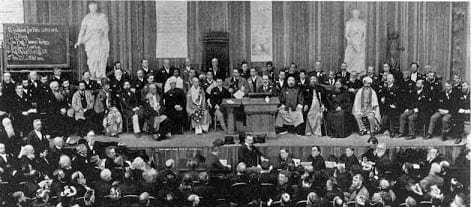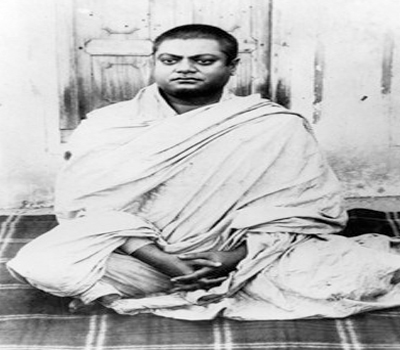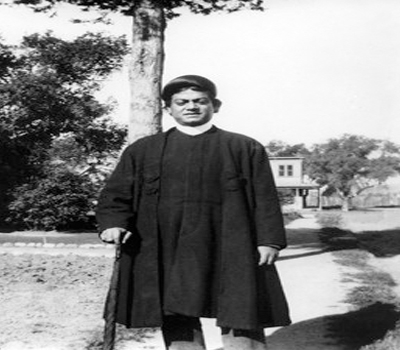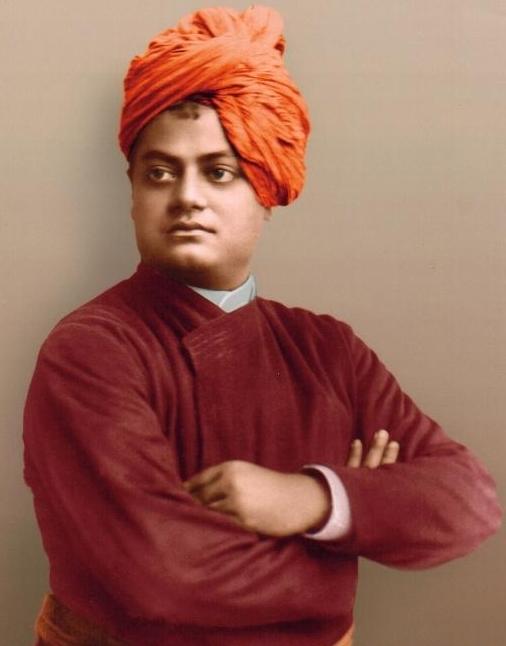ANY ONE WHO AS READ Swami Vivekananda’s ‘Memoirs of European Travel ’1 will agree that he had a quick eye and keen power of observation. And this is evident throughout his memoirs and letters. His observations were backed by a deep interest in world history and human nature, which made his narratives highly interesting. Swamiji also had a superb insight that penetrated into the heart of what he observed.
Swamiji visited China only once and spent three days there. He only saw Hong Kong and Guangzhou, then called Canton, so the glimpses he gives are fragmentary. While he was travelling to Chicago to attend the World Parliament of Religions, his ship, the P & O Peninsular, docked in Hong Kong for three days in June 1893. He took advantage of this time to travel the 80 miles up the Pearl River to Canton, where he managed to visit one of the Chinese Buddhist temples.2
Hong Kong
Swamiji wrote a long letter to Alasinga Perumal and other friends in Madras from Yokohama on 10 July 1893 giving the details of his stay:
Hong Kong is real China. As soon as the steamer casts anchor, you are besieged with hundreds of Chinese boats to carry you to the land. Th ese boats with two helms are rather peculiar. The boatman lives in the boat with his family. Almost always, the wife is at the helms, managing one with her hands and the other with one of her feet. And in ninety per cent of cases, you find a baby tied to her back, with the hands and feet of the little Chin [sic] left free. It is a quaint sight to see the little John Chinaman dangling very quietly from his mother’s back, whilst she is now setting with might and main, now pushing heavy loads, or jumping with wonderful agility from boat to boat. And there is such a rush of boats and steam-launches coming in and going out.3
The boats Swamiji refers to were probably sampans, which are still used. They are usually 3.5 to 4.5 metres long and often have a shelter that can be used as permanent living quarters, if you do not mind a little crowding. The ‘two helms’ Swamiji refers to may have been oars. Swamiji’s narrative continues:
Baby John is every moment put into the risk of having his little head pulverised, pigtail and all; but he does not care a fig. This busy life seems to have no charm for him, and he is quite content to learn the anatomy of a bit of rice-cake given to him from time to time by the madly busy mother. The Chinese child is quite a philosopher and calmly goes to work at an age when your Indian boy can hardly crawl on all fours. He has learnt the philosophy of necessity too well. Their extreme poverty is one of the causes why the Chinese and the Indians have remained in a state of mummified civilisation. To an ordinary Hindu or Chinese, everyday necessity is too hideous to allow him to think of anything else (5.7).
Why was the Chinese baby, a boy, wearing a pigtail? In those days China was ruled by the Manchus, people from Manchuria who wore their hair in a long queue, or pigtail. They conquered China in the seventeenth century ce,founded the Qing dynasty, and forced the ethnic Han Chinese to wear their hair in the Manchu style as a sign of subjugation, under penalty of death. Not until the Qing dynasty fell in 1911 were the Chinese allowed to cut off their queues.
Swamiji resumes: ‘Hong Kong is a very beautiful town. It is built on the slopes of hills and on the tops too, which are much cooler than the city. There is an almost perpendicular tramway going to the top of the hill, dragged by wire-rope and steam-power (ibid.).
The Peak Tram, as it is now called, had been opened in 1888, only five years before Swamiji’s visit, so it was relatively new at the time. It was the first funicular railway in Asia. It is still there, but has been much modernized—electricity replaced coal-driven steam power in 1926. It is a popular tourist attraction, now serving 17,000 people per day, and relatively cheap. Before it was built the only access to the summit of the hill was by sedan chair or palanquin, carried by two coolies.
The hill Swamiji mentions is Victoria Peak, popularly called the Peak, and at 552 metres it is the highest point on Hong Kong Island. In Swamiji’s day it was the residence mainly of British officials and expatriates trying to escape the summer heat. Like its tram, the Peak is a famous tourist attraction, now drawing seven million visitors per year. The view is spectacular, especially at night, encompassing Hong Kong Island, Kowloon, and Victoria Harbour.
Canton
Swamiji’s narrative continues: ‘We remained three days at Hong Kong and went to see Canton, which is eighty miles up a river [the Pearl River]. The river is broad enough to allow the biggest steamers to pass through. A number of Chinese steamers ply between Hong Kong and Canton. We took passage on one of these in the evening and reached Canton early in the morning. What a scene of bustle and life! What an immense number of boats almost covering the waters!’ (Ibid.).
Swamiji comments on the Chinese customs of the day: ‘The Chinese ladies can never be seen. They have got as strict a zenana as the Hindus of Northern India; only the women of the labouring classes can be seen. Even amongst these, one sees now and then a woman with feet smaller than those of your youngest child, and of course they cannot be said to walk, but hobble’ (5.8).
This refers to the old Chinese custom of foot binding, which started among the aristocracy in the tenth century ce and later spread to the other classes. In those days the Chinese regarded big feet as ugly and considered dancing girls with small feet to be the epitome of beauty. The ideal size for a woman’s foot, believe it or not, was a mere seven centimetres. So parents would break their daughters’ feet from an early age by bending the toes backward to touch the heels and bind them in that position with cloth wrappings. Of course, both the process and its aftermath were horribly painful, and the victims were crippled for life. But tiny feet gave women great prestige. It made them desirable as wives and signified that they were so rich they did not have to work. The way they hobbled was also considered alluring. This barbarous custom eventually died out in the early twentieth century, doubtless to the great relief of Chinese women.
Swamiji resumes: ‘I went to see several Chinese temples. The biggest in Canton is dedicated to the memory of the first Buddhistic Emperor and the five hundred first disciples of Buddhism. The central figure is of course Buddha, and next beneath Him is seated the Emperor, and ranging on both sides are the statues of the disciples, all beautifully carved out of wood’ (ibid).
Despite an extensive search, I have been unable to identify this temple. Swamiji’s description is puzzling. The two best-known temples in Guangzhou today are the Temple of the Six Ban-yans (Liurong Si) and the Temple of Bright Filial Piety (Guangxiao Si). Neither seems to match Swamiji’s description. They both have prominent pagodas, but Swamiji does not mention a pagoda. The ‘first Buddhistic Emperor’ to rule over a unified China seems to have been Emperor Wen of the Sui Dynasty, who ruled from 581–604 ce. I know of no temple in contemporary Guangzhou that might have been dedicated to him.
The description of the images is also puzzling, because in most Chinese temples the image of Sakyamuni Buddha is flanked by two other Buddhas, Amitabha and Bhaisajya, with no image of any emperor anywhere. Perhaps the temple Swamiji visited was different. As for the statues of the five hundred disciples, one current temple, Hualin Si, does have statues of five hundred arhats, although the rest of Swamiji’s description does not match it. But many of the temples that existed during Swamiji’s time may have been modified since—or destroyed during the Cultural Revolution (1966–76). It is possible that the temple he visited no longer exists.
Adventure in a Chinese Monastery
Swamiji had an adventure in Canton. As a monk his earnest desire was to visit a Chinese monastery. Unfortunately, these monasteries were forbidden ground to foreigners. What could be done? When he asked the interpreter, he was told that a visit was impossible. But this served only to intensify his desire: he must see a Chinese monastery! He said to the interpreter, ‘Suppose a foreigner should go there, what then?’ and received the reply, ‘Why, sir, they would be sure to maltreat him!’ The Swami thought that if the monks knew him to be a Hindu sannyasi, they would not molest him. So he persisted, and finally induced the interpreter and his fellow passengers to tread ‘forbidden ground,’ saying laughingly, ‘Come, let us see if they will kill us!’ But they had not gone far when the interpreter cried out, ‘Away! Away, gentlemen! They are coming, and they are infuriated!’ Two or three men with clubs in their hands were approaching rapidly. Frightened at their menacing appearance, all but the Swami and the interpreter took to their heels. When even the latter was on the point of fleeing, the Swami seized him by the arm and said with a smile, ‘My good man, you must not run away before you tell me the Chinese word for Indian Yogi.’ Having been told this, the Swami loudly called out that he was an Indian Yogi. And lo, the word for ‘Yogi’ acted like magic! The angry expressions of the men changed to that of deep reverence and they fell at his feet. They rose, stretched out their joined palms in most respectful salutation, and then said some-thing in a loud voice, one word of which the Swami understood to be ‘Kabatch’. He thought that it was undoubtedly the Indian word meaning amulet; but to be sure of what they meant, he shouted a question to the interpreter, who stood at a safe distance, confounded at these
strange developments. … For an explanation he said, ‘Sir, they want amulets to ward off evil spirits and unholy influences. They desire your protection.’ The Swami was taken aback for a moment. He did not believe in charms. Then he took a sheet of paper from his pocket, divided it into several pieces, and wrote on them the word ‘Om’ in Sanskrit. … He gave them the pieces of paper, and the men, touching them to their heads, led him into the monastery.
In the more isolated portions of the building he was shown many Sanskrit manuscripts, written, strange to say, in old Bengali characters. And then it occurred to him that when he had visited the temple dedicated to the first Buddhist Emperor he had been struck with the unmistakable resemblance between the faces of the Blessed One’s five hundred followers and those of Bengalis. These evidences, as also his past study of Chinese Buddhism, convinced him that Bengal and China had at one time been in close communication, that there must have been a great influx into China of Bengali Bhikkhus (Buddhist monks), who brought to that distant country the gospel of the Blessed One, and that Indian thought had influenced Chinese civilization to a signifi cant extent.4
From Hong Kong Swamiji sailed to Japan, where ‘to his amazement he found that here also the temples were inscribed with Sanskrit Mantras in old Bengali characters, although only a few of the priests knew Sanskrit’ (1.398).
What were these old Bengali characters? Surprisingly, some inscriptions in them have survived down to the present time. I recall seeing, many years ago, a few old Buddha images, both on Taiwan and the Mainland, with fillets hanging down from the shoulders inscribed with characters that looked to be in some sort of Indian script. They were not Devanagari, nor Bengali, nor Tibetan—to my untutored eye they resembled Punjabi—but they were obviously of Indian origin. Nobody I asked knew how to read them.
While researching for this article, I decided to look into this. I emailed an old friend, Professor Victor H Mair, a distinguished Sinologist at the University of Pennsylvania, and asked him about it. He replied that the inscriptions, and probably the Sanskrit mantras Swamiji saw, were almost certainly written in a script called Siddham. He also sent me additional information and links.
It turns out that Siddham is the name of a North Indian script used for writing Sanskrit during the period c.600–1200 CE. It is descended from the Brahmi script through the Gupta script, which also gave rise to the Devanagari script as well as a number of other Asian scripts such as the Tibetan script. Many of the Buddhist texts, which were taken to China along the Silk Road, were written using a version of the Siddham script. This continued to evolve, and minor variations are seen across time, and in diff erent regions. Importantly, it was used for transmitting the Buddhist tantra texts. At the time it was considered important to preserve the pronunciation of mantras, and Chinese was not suitable for writing the sounds of Sanskrit. This led to the retention of the Siddham script in East Asia.5
The script also spread to Japan, where the writing of mantras and the copying of sutras using the Siddham script is still practised in the esoteric Buddhist schools of Shingon and Tendai. The Taisho edition of the Chinese Tripitaka preserves the Siddham characters for most mantras (ibid.).
The remark that ‘Chinese was not suitable for writing the sounds of Sanskrit’ is an under-statement. Each Chinese character represents a syllable, and there is a limited number of characters. So the Chinese characters for ‘Sakya-muni Buddha’ are pronounced ‘Shijiamouni Fo’; the mantra ‘Namo Amitabha Buddha’ becomes ‘Nanwu Amito Fo’; and ‘Prajnaparamita’ comes out as ‘Poruopoluomiduo’—in modern times Sri Ramakrishna’s name comes out as ‘Shili Luomokelixina’.
If Swami Vivekananda were to visit China today, he would find that, instead of trying to construct a phonetic approximation of his own name, which would probably come out as ‘Wei-wei-jia-nan-duo’, the Chinese have mercifully translated it as ‘Bianxi’, meaning ‘Discrimination-Happiness’. But one thing he would not miss is what he had said in connection with China: ‘I see before me the body of an elephant. Th ere is a foal within. But it is a lion-cub that comes out of it. It will grow in future, and China shall become great and powerful.’6
(Source: Prabuddha Bharatha January 2013)
References
1. The Complete Works of Swami Vivekananda, 9 vols (Calcutta: Advaita Ashrama, 1–8, 1989; 9, 1997), 7.295–404.
2. Alan Hunter, ‘Swami Vivekananda in China’, Nirvana, 57 (April-June 2008), 3.
3. Complete Works, 5.6–7.
4. His Eastern and Western Disciples, The Life of Swami Vivekananda, 2 vols (Kolkata: Advaita Ashrama, 2008), 1.395–7.
5. See Wikipedia, under ‘Siddham alpha-bet’, <http://en.wikipedia.org/wiki/Siddha%E1%B9%83_alphabet>, accessed 13 November 2012.
6. The Life of Swami Vivekananda, 2.559.







Leave A Comment